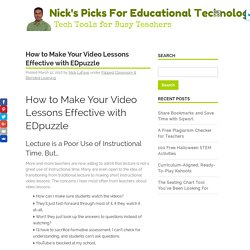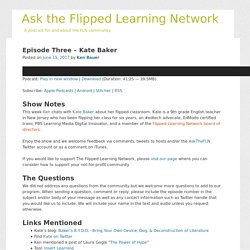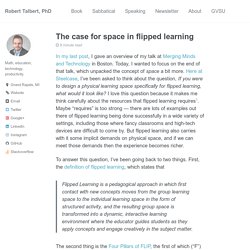

Pillar 4: Professional Educator Archives - Flipped Learning Network Hub. Flip a Lesson Plan! How to Make Your Video Lessons Effective with EDpuzzle. Lecture is a Poor Use of Instructional Time, But… More and more teachers are now willing to admit that lecture is not a great use of instructional time.

Many are even open to the idea of transitioning from traditional lecture to making short instructional video lessons. The concerns I hear most often from teachers about video lessons: How can I make sure students watch the videos? They’ll just fast-forward through most of it, if they watch it at-all.Won’t they just look up the answers to questions instead of watching?
EDpuzzle is a Game-ChangerEDpuzzle.com While it can’t do much about the tyranny of blocking a valuable educational resource like YouTube, EDpuzzle can address many of these concerns. Teachers can create lessons by embedding questions within their videos. Use Nearly Any Video Free, Unlimited Video Hosting I cannot stress enough the value of making your own instructional videos. Off The Shelf Videos Turn Videos into Lessons Crop Record Your Voice Add Audio Notes. Ask the Flipped Learning Network. Podcast: Play in new window | Download (Duration: 41:25 — 39.5MB) Subscribe: Apple Podcasts | Android | Stitcher | Show Notes This week Ken chats with Kate Baker about her flipped classroom.

Kate is a 9th grade English teacher in New Jersey who has been flipping her class for six years, an #edtech advocate, EdModo certified traini, PBS Learning Media Digital Innovator, and a member of the Flipped Learning Network board of directors. Enjoy the show and we welcome feedback via comments, tweets to hosts and/or the AskTheFLN Twitter account or as a comment on iTunes. If you would like to support The Flipped Learning Network, please visit our page where you can consider how to support your not-for-profit community.
The Questions We did not address any questions from the community but we welcome more questions to add to our program. Links Mentioned From FLN Slack conversation with Robert Talbert: Ken’s Take. The case for space in flipped learning - Robert Talbert, PhD. In my last post, I gave an overview of my talk at Merging Minds and Technology in Boston.

Today, I wanted to focus on the end of that talk, which unpacked the concept of space a bit more. Here at Steelcase, I’ve been asked to think about the question, If you were to design a physical learning space specifically for flipped learning, what would it look like? I love this question because it makes me think carefully about the resources that flipped learning requires. Maybe “requires” is too strong — there are lots of examples out there of flipped learning being done successfully in a wide variety of settings, including those where fancy classrooms and high-tech devices are difficult to come by. But flipped learning also carries with it some implicit demands on physical space, and if we can meet those demands then the experience becomes richer.
To answer this question, I’ve been going back to two things. First: The default setting for a flipped learning space should be “social”. What’s an In-Class Flip? - Flipped Learning Network Hub. --Originally published at flipping – Martha Ramirez Here’s an explanation of in-class flip with its types of stations, sequencing and examples based on trial and error (still in process). What is in-class flip? Types of in-class flips Mixed sequence stations explanation Mixed sequenced in-class flip example Mixed sequence student flow Simple sequence stations explanation Simple sequenced stations example What to do with large classes (In a sequenced flip) Some ideas for station work It is important to note that every in-class flip will vary depending on number of students, physical class space, resources, class focus and student dynamic, among other aspects.
References: Barnes, M., & Gonzalez, J. (2015).